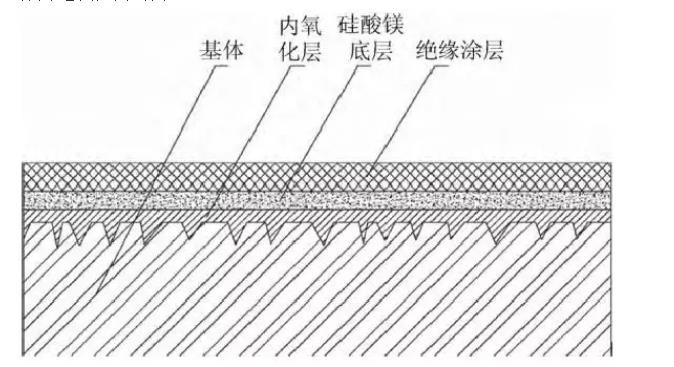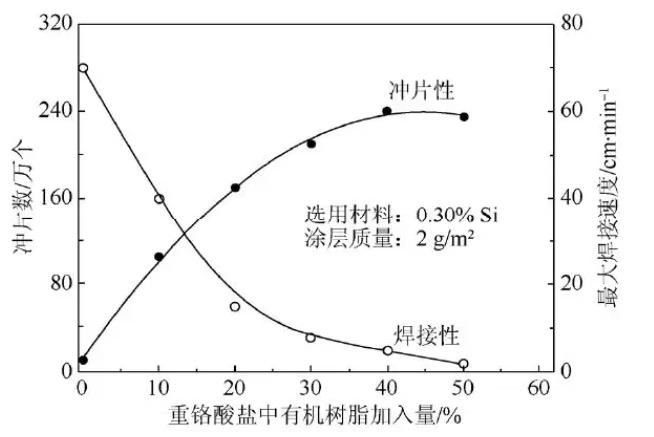NEWS CENTER
Development Status of Surface Insulating Coating on Oriented Silicon Steel
- Time of issue:2018-11-22 18:22
(Summary description)The preparation of the coating is the last process in the production of silicon steel. The type, process and quality of the surface coating will have a great impact on the insulation, adhesion, punching and corrosion resistance of the electrical steel, and then affect the electrical steel. Its own specific total loss and other magnetic properties are even the key to the safe operation of the entire transformer.
Development Status of Surface Insulating Coating on Oriented Silicon Steel
(Summary description)The preparation of the coating is the last process in the production of silicon steel. The type, process and quality of the surface coating will have a great impact on the insulation, adhesion, punching and corrosion resistance of the electrical steel, and then affect the electrical steel. Its own specific total loss and other magnetic properties are even the key to the safe operation of the entire transformer.
- Categories:Industry News
- Author:Wu Xue et al
- Origin:Smart grid
- Time of issue:2018-11-22 18:22
- Views:
The preparation of the coating is the last process in the production of silicon steel. The type, process and quality of the surface coating will have a great impact on the insulation, adhesion, punching and corrosion resistance of electrical steel, which will affect the electrical steel. Its own specific total loss and other magnetic properties are even the key to the safe operation of the entire transformer.
Oriented silicon steel, as an important magnetic material, has excellent properties of high magnetic induction and low iron loss, and is often widely used in the core material of power transformers.
The untreated electrical steel sheet will corrode and rust, which not only affects the performance of the silicon steel material itself, but also threatens the safety of power grid operation. Under normal circumstances, the surface of silicon steel sheet needs to be coated with a very thin ((0.5-5 μm) insulation coating, so that the silicon steel sheet has a high interlayer resistivity and minimizes the power loss between silicon steel sheets. At the same time, the silicon steel sheet is protected from various corrosive media during storage, transportation and use to prevent corrosion.
The magnesium silicate bottom layer formed by silicon steel after high temperature annealing has certain insulation and corrosion resistance, and at the same time, tensile stress is generated in the steel, and its interlayer resistance is greater than 4Ω·cm?/piece, which can meet the needs of wound core distribution transformers However, for medium and large transformers with laminated cores, the resistance is not large enough, and an insulating coating must be coated on the surface. The schematic diagram of the surface cross-section of the oriented silicon steel product is shown in Figure 1.

The preparation of the coating is the last process in the production of silicon steel. The type, process and quality of the surface coating will have a great impact on the insulation, adhesion, punching and corrosion resistance of electrical steel, which will affect the electrical steel. The specific total loss and other magnetic properties are even the key to the safe operation of the entire transformer. There is an urgent need to develop insulating coating materials with excellent performance, which not only have good electrical insulation, coating adhesion, and relatively Good punching and shearing processability, weldability, corrosion resistance and heat resistance, can adapt to 700-800℃ high temperature annealing, at the same time have high stacking coefficient, uniform surface color and other performance characteristics. Domestic and foreign are constantly researching and improving the coating process to further improve the performance of oriented silicon steel products.
1. Research overview of oriented silicon steel coatings abroad
The surface insulation coatings of oriented silicon steel used in domestic and foreign research mainly include organic coatings, semi-inorganic coatings and inorganic coatings. Organic coatings are relatively traditional insulating coatings in China. They are mainly organic resins such as acrylic resin, vinyl acetate resin, modified alkyd resin and epoxy resin, and are usually used to manufacture high-grade silicon steel for large motors. The organic coating has good film-forming properties, good insulation and impact resistance, high shear punching and interlayer resistance, but the paint film has low hardness, large heat shrinkage deformation, poor heat resistance and weldability, and heat Creep easily occurs afterwards. It can be seen from Figure 2 that with the increase of the organic resin content in the coating, the punching property improves, but the weldability decreases. However, in some special occasions, the coating needs to be heat-treated at 600°C before being used as an insulating coating. Most of the resin in the organic coating has been degraded and volatilized at 600°C, losing its insulating ability, and volatilizing harmful gases, causing environmental pollution. Therefore, stress-relieving annealing treatment cannot be performed. At present, organic coatings have been gradually eliminated.

In order to improve the adverse effects of large secondary grains on iron loss, Nippon Steel proposed a stress coating of ultrafine colloidal SiO2 mixed with phosphate solution. The stress coating produces isotropic tensile stress on the surface of the steel plate, making the iron loss P And magnetostriction is almost reduced, and at the same time, it can offset the adverse effects of external stress on silicon steel. Kawasaki uses magnesium phosphate (Mg(H2PO4)2) as the main stress coating with colloidal Si02 and Cr03, which improves the moisture resistance of the coating and also improves the appearance. However, the chromium compound contains hexavalent Cr, the paint pollutes the environment, and the waste liquid treatment is troublesome. Nippon Steel has proposed to use solid solution composite metal hydroxide with an average particle size of less than 1 μm or 2-3 μm plus borate and acetate. , Silicate, etc., good adhesion, corrosion resistance and sintering resistance, but moisture resistance and heat resistance are not ideal. Adding fine particles of colloidal oxide can react with free phosphoric acid to form a more stable phosphoric acid compound, thereby improving moisture resistance and heat resistance, and better lubricity. In order to prevent particle colloidal oxide from agglomerating, organic acid salt is added, but the coating solution is not stable. Add inorganic compounds such as ultrafine particles of about 10 nm such as Fe(OH)2 to adjust the structure of colloidal oxide and make the phosphate solution more stable. .
Semi-inorganic coating is an insulating coating formed by mixing inorganic phosphate and chromate solutions and latex resin solutions. Add organic resin particles with a particle size of 2-50 μm to the latex resin, then mix with the inorganic solution and coat them on the surface of the silicon steel for baking. The inorganic component of the traditional semi-inorganic coating is chromate, which has good corrosion resistance. The organic resin powder is usually one or several kinds of polyethylene, polypropylene, polyphthalamide, benzodiamino triacetin, polypropylene resin or copolymer or mixture of polystyrene, among which polystyrene The braced copolymer has the best adhesive strength.
Tension coating first proposed by Nippon Steel in 1973, its main component is ultrafine colloidal SiO2 (silica sol) mixed with phosphate coating solution. The tensile stress generated by the coating can refine the magnetic domains and effectively reduce the iron loss and magnetostriction. Relevant studies have shown that by adjusting the coating formula and using appropriate drying and sintering processes, iron loss P1.7 can be reduced by as much as 0.1 W/kg.
In order to reduce the iron loss of oriented silicon steel, one of the most effective methods is to develop new coating technology. The research results show that the magnesium oxide coating has an important influence on the magnetic properties and surface properties of oriented silicon steel. In addition, Japan has adopted chemical vapor deposition to coat the film to form a ceramic insulating film instead of a forsterite film, using laser processing and changing the type of inorganic acid in the insulating film coating liquid to reduce iron loss. The results show that by improving the composition of the insulating film coating solution, increasing the viscosity stability and film tension, oriented silicon steel sheets with high magnetic induction and low iron loss can be obtained.
At present, foreign countries have made certain research progress in the field of new technology research on environmental protection coatings, but satisfactory results have not been achieved in terms of ensuring the overall performance of insulating coatings.
2. Research status of oriented silicon steel surface coating in my country
The hot-rolled silicon steel in the 1940s used the method of coating insulating paint on the surface. In the 1980s, my country still continued to use this method, even coating the cold-rolled silicon steel with glass coating with insulating paint. In the early days of our country, pure organic coatings were mainly studied. In view of the shortcomings of low hardness and poor heat resistance, domestic silicon steel companies currently use less.
Later, the United States, Japan and other companies have successively developed phosphate surface coatings with better insulation properties. However, chromate is generally added to the previous coatings to improve the corrosion resistance and interlayer resistance of the coating. For a long time, almost all insulating coating materials containing hexavalent chromium have been used in the production of cold-rolled silicon steel in China. There is no clear standard for the environmental protection of insulating coatings. Water-based chromium-free silicon steel coatings usually use water as the main solvent. It is an environmentally friendly coating, but this kind of inorganic coating is restricted by various conditions in practical applications. At present, semi-inorganic coatings are still the mainstay in China. The semi-inorganic insulating coatings used by domestic steel companies are mainly shown in Table 1.


3. Development direction of insulating coating on silicon steel surface
The core loss, magnetostriction and surface quality of oriented silicon steel are closely related to the surface insulation coating. The tensile stress generated by the coating on the silicon steel sheet can offset the compressive stress generated by the material in the transformer assembly, thereby reducing the noise of the transformer. Due to the coating, the steel sheet is less sensitive to stress during magnetostriction, and the noise of the transformer is also reduced. At the same time, the insulating coating of oriented silicon steel sheet has the effect of reducing the specific total loss, and the iron loss can be reduced by 9%-14%. Research and application of high-performance silicon steel surface insulating coatings have an important impact on improving the overall performance of oriented silicon steel.
In the production and use of coatings and the discharge of waste liquids, hexavalent chromium will cause serious harm. Although semi-inorganic coatings have improved some of the shortcomings of inorganic coatings and organic coatings, and are currently the most widely used, some of the volatile organic solvents contained in them are also toxic. It is necessary to minimize or even eliminate volatile organic solvents. The development of inorganic coatings with excellent performance is a research focus of insulating coatings. Therefore, chromium-free environmentally friendly inorganic oriented silicon steel insulation coating is the key development direction of oriented silicon steel insulation coating.
4 Conclusion
1. The surface insulation coating can reduce iron loss, weaken the sensitivity of magnetostriction to stress, and reduce transformer noise. It is an important process in the production process of oriented silicon steel.
2. The surface insulating coatings of oriented silicon steel used in domestic and foreign research mainly include organic coatings, semi-inorganic coatings and inorganic coatings. Organic coatings have been eliminated, and inorganic coatings will gradually replace semi-inorganic coatings.
3. In order to meet environmental protection requirements, research and perfection of chromium-free environmentally friendly inorganic coatings that do not contain chromium elements and do not contain volatile organic components is the development direction of silicon steel surface insulating coatings.
Hot News

黄石山力科技股份有限公司
Sunny Technologies Incorporation Limted

Contact us
Add:No. 2, Guangzhou road, tuanshancheng Development Zone, Huangshi City, No. 101, Gaoxin 6th Road, Donghu New Technology Development Zone, Wuhan
Mail:spt@sunnychina.com.cn
Tel:156 7177 7755 / 027-59715061
Fax:027-59715060





